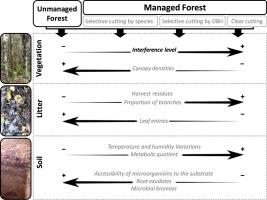当前位置:
X-MOL 学术
›
Forest Ecol. Manag.
›
论文详情
Our official English website, www.x-mol.net, welcomes your
feedback! (Note: you will need to create a separate account there.)
Short-term effects of forest management on soil microbial biomass and activity in caatinga dry forest, Brazil
Forest Ecology and Management ( IF 3.7 ) Pub Date : 2021-02-01 , DOI: 10.1016/j.foreco.2020.118790 Patrícia Anjos Bittencourt Barreto-Garcia , Suellen Gomes Monteiro Batista , Emanuela Forestieri da Gama-Rodrigues , Alessandro de Paula , Willyan Charles Amaral Batista
Forest Ecology and Management ( IF 3.7 ) Pub Date : 2021-02-01 , DOI: 10.1016/j.foreco.2020.118790 Patrícia Anjos Bittencourt Barreto-Garcia , Suellen Gomes Monteiro Batista , Emanuela Forestieri da Gama-Rodrigues , Alessandro de Paula , Willyan Charles Amaral Batista

|
Abstract The Caatinga is among the most threatened and least studied tropical dry forests in the world. Sustainable forest management is a rational exploitation practice adopted in the biome, but it can impact a variety of ecosystem attributes. We still have a limited understanding of forest management impacts on the soil, especially on microbial biomass. Thus, we developed this work by asking how do soil microbial biomass and activity respond in the short-term to Caatinga forest management and how do these responses differ between forest management practices? Three types of forest management were evaluated (clear cutting - CC, selective cutting by diameter - SCD, and selective cutting by species - SCS), using unmanaged Caatinga (UC) as a reference. Litter and soil (depth of 0–10 cm) collections were carried out. Soil microbial activity was determined based on the amount of evolved CO2, and the microbial biomass C and N were estimated by the fumigation-extraction method. The management provided a reduction in leaf litter (CC = 16%; SCD = 25%; SCS = 38%; UC = 55%) and an increase in branch litter (CC = 73%; SCD = 66%; SCS = 46%; UC = 35%). It also caused a 42% reduction in MB-C. The metabolic quotient had an increase in CC and SCD management (average of 690.6 mg g−1 day) compared to UC (365.9 mg g−1 day). SCD and CC influenced the activity and C transformation of soil microbial biomass in the short-term, while SCS less intensely affected these variables, approaching the unmanaged forest condition.
中文翻译:

森林管理对巴西卡廷加旱林土壤微生物生物量和活性的短期影响
摘要 卡廷加是世界上受威胁最严重、研究最少的热带干旱森林之一。可持续森林管理是生物群落中采用的合理开发实践,但它会影响各种生态系统属性。我们对森林管理对土壤的影响的了解仍然有限,尤其是对微生物生物量的影响。因此,我们通过询问土壤微生物生物量和活动在短期内对卡廷加森林管理有何响应以及这些响应在森林管理实践之间有何不同来开展这项工作?使用未管理的卡廷加 (UC) 作为参考,评估了三种森林管理类型(明伐 - CC、按直径选择伐 - SCD 和按物种选择伐 - SCS)。进行了垃圾和土壤(0-10 厘米深度)的收集。土壤微生物活性根据释放的 CO2 量确定,微生物生物量 C 和 N 通过熏蒸提取法估算。管理提供了落叶减少(CC = 16%;SCD = 25%;SCS = 38%;UC = 55%)和增加树枝凋落物(CC = 73%;SCD = 66%;SCS = 46%) ;UC = 35%)。它还导致 MB-C 减少了 42%。与 UC(365.9 mg g-1 天)相比,代谢商在 CC 和 SCD 管理(平均 690.6 mg g-1 天)方面有所增加。SCD和CC在短期内影响土壤微生物生物量的活性和C转化,而SCS对这些变量的影响较小,接近未管理的森林条件。管理提供了落叶减少(CC = 16%;SCD = 25%;SCS = 38%;UC = 55%)和增加树枝凋落物(CC = 73%;SCD = 66%;SCS = 46%) ;UC = 35%)。它还导致 MB-C 减少了 42%。与 UC(365.9 mg g-1 天)相比,代谢商在 CC 和 SCD 管理(平均 690.6 mg g-1 天)方面有所增加。SCD和CC在短期内影响土壤微生物生物量的活性和C转化,而SCS对这些变量的影响较小,接近未管理的森林条件。管理提供了落叶减少(CC = 16%;SCD = 25%;SCS = 38%;UC = 55%)和增加树枝凋落物(CC = 73%;SCD = 66%;SCS = 46%) ;UC = 35%)。它还导致 MB-C 减少了 42%。与 UC(365.9 mg g-1 天)相比,代谢商在 CC 和 SCD 管理(平均 690.6 mg g-1 天)方面有所增加。SCD和CC在短期内影响土壤微生物生物量的活性和C转化,而SCS对这些变量的影响较小,接近未管理的森林条件。
更新日期:2021-02-01
中文翻译:

森林管理对巴西卡廷加旱林土壤微生物生物量和活性的短期影响
摘要 卡廷加是世界上受威胁最严重、研究最少的热带干旱森林之一。可持续森林管理是生物群落中采用的合理开发实践,但它会影响各种生态系统属性。我们对森林管理对土壤的影响的了解仍然有限,尤其是对微生物生物量的影响。因此,我们通过询问土壤微生物生物量和活动在短期内对卡廷加森林管理有何响应以及这些响应在森林管理实践之间有何不同来开展这项工作?使用未管理的卡廷加 (UC) 作为参考,评估了三种森林管理类型(明伐 - CC、按直径选择伐 - SCD 和按物种选择伐 - SCS)。进行了垃圾和土壤(0-10 厘米深度)的收集。土壤微生物活性根据释放的 CO2 量确定,微生物生物量 C 和 N 通过熏蒸提取法估算。管理提供了落叶减少(CC = 16%;SCD = 25%;SCS = 38%;UC = 55%)和增加树枝凋落物(CC = 73%;SCD = 66%;SCS = 46%) ;UC = 35%)。它还导致 MB-C 减少了 42%。与 UC(365.9 mg g-1 天)相比,代谢商在 CC 和 SCD 管理(平均 690.6 mg g-1 天)方面有所增加。SCD和CC在短期内影响土壤微生物生物量的活性和C转化,而SCS对这些变量的影响较小,接近未管理的森林条件。管理提供了落叶减少(CC = 16%;SCD = 25%;SCS = 38%;UC = 55%)和增加树枝凋落物(CC = 73%;SCD = 66%;SCS = 46%) ;UC = 35%)。它还导致 MB-C 减少了 42%。与 UC(365.9 mg g-1 天)相比,代谢商在 CC 和 SCD 管理(平均 690.6 mg g-1 天)方面有所增加。SCD和CC在短期内影响土壤微生物生物量的活性和C转化,而SCS对这些变量的影响较小,接近未管理的森林条件。管理提供了落叶减少(CC = 16%;SCD = 25%;SCS = 38%;UC = 55%)和增加树枝凋落物(CC = 73%;SCD = 66%;SCS = 46%) ;UC = 35%)。它还导致 MB-C 减少了 42%。与 UC(365.9 mg g-1 天)相比,代谢商在 CC 和 SCD 管理(平均 690.6 mg g-1 天)方面有所增加。SCD和CC在短期内影响土壤微生物生物量的活性和C转化,而SCS对这些变量的影响较小,接近未管理的森林条件。









































 京公网安备 11010802027423号
京公网安备 11010802027423号